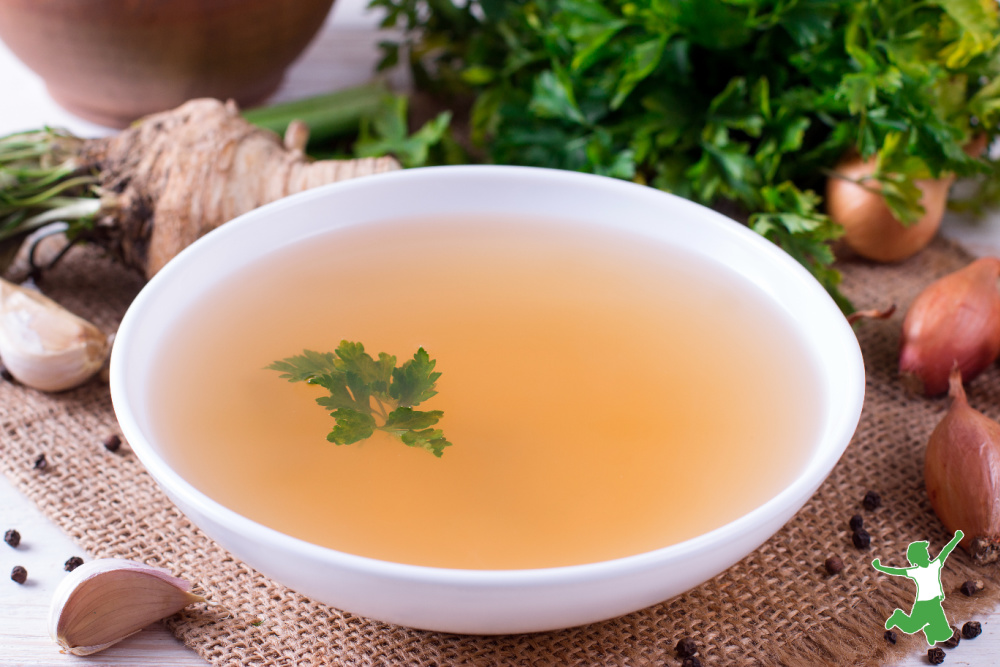How the French art of remouillage makes the most of your real food budget by saving money making bone broth or stock.

The Culinary Arts Dictionary defines the French word remouillage as a weak stock made by resimmering bones that have been used to make bone broth once already.
Indeed, this is exactly what remouillage is: a rewetting or remoistening of soup bones that have already served their purpose with a previous batch of bone broth or stock (not to be confused with meat stock).
It is a frugal approach to using broth bones much like boiling meat is the thiftiest way to cook it on a tight budget.
Despite the fact that my Father’s side of the family is French, I only started practicing remouillage well into the second decade of my traditional foods journey.
Folks had mentioned to me in the past that they “reused soup bones”. At first, this approach seemed to be an example of frugality run amok.
If you’ve simmered bones once, how could resimmering them possibly achieve anything close to the delectable flavor and superior nutrition of first batch?
As it turns out, there is always something new to learn with Traditional Cooking!
Broth from Reused Bones
The second batch of stock made from the same soup bones is definitely weaker than the first.
This is the case even when adding fresh carrots, celery, onions, and a bay leaf or two. Note that it is not advisable to reuse the vegetables from the first batch of stock.
However, you can easily compensate for this by simply boiling the remouillage down until the flavor and color is roughly comparable with the first batch.
The final result yields less stock – about half in my experience. The upside is that you will have more thoroughly made use of your investment in quality soup bones!
What Type of Bones Work for Remouillage?
What types of bones work best when making remouillage?
I’ve used all types of poultry (including chicken feet) and beef bones. All have worked very well and produced excellent results.
I am not in favor of using fish heads for stock more than once. The heads pretty much disintegrate after the first batch, and fish heads are so cheap to buy anyway. I pay $1.50/lb for top quality snapper heads.
Making Stock With the Same Bones More than Twice?
Some cooks claim to use hard bones like beef or buffalo for making stock not once, not twice, but three or more times!
An article by Amanda Rose on The Nourishing Gourmet claims that high gelatin bones called “beef feet” can produce up to 12 batches of gelatinous stock!
How many times should you make remouillage considering that each batch will have less flavor than the previous one?
The choice is totally up to you.
Certainly, when the bones disintegrate is a good sign to stop. This happens with fish heads which are good for only a single batch.
However, if you have beef bones that are still hard and obviously have some minerals left in them after the first couple of batches, then go ahead and make another batch and see what happens.
Best Uses for “Second Batch Bone Broth”
It’s important to keep in mind that you aren’t losing anything by making a second batch of broth with the same bones.
If the stock turns out too weak tasting, simply boil it down. This will concentrate the flavor until it is acceptable to use as a base for your soups, sauces, and gravies.
Other uses for weak, second batch broth include:
- Weak remouillage is perfect for cooking rice or quinoa instead of plain filtered water.
- Use it to make savory soaked oatmeal instead of the typical sweet versions.
- Remouillage makes a tasty base for mashed potatoes.
- Try cooking up your next pot of sourdough pasta in remouillage instead of water.
Are you already a fan of this French art of using bones twice to make broth? If so, please share your experience!









Thank you, Sarah! I appreciate your expertise and your kindness in sharing freely with all of us! I love your bone broth recipes and will certainly explore more of your website. Many blessings to you!
After making a traditional broth with my chicken and veggies and simmering it for around 20 hours I am wondering how one is to remove the veggies in order to do a remouillage minus the vegetables!? Mine have totally integrated themselves into the meat mixture remaining after I removed and package my broth!!
Thanks for this info. I was searching on google if I could do this since I just finished a batch of broth. I will definitely be trying tonight!
Aaand that’s how all of us blogger’s work! I look like that right now. You’d never think we write about our travel’s for a living when we’re bundled up like that, would you? Haha! Great post, so true!
I like very much this recipe
rosehip oil
Calcium amounts in bone broths– I’m curious if you (Sarah) or anyone else has ever had their broth analyzed for nutritional amounts of calcium? I am using it instead of milk for my 15month old (allergic to dairy of all sorts!) and my pediatrician is of course, freaking out that she isn’t getting any calcium. I am using pastured chicken and beef bones, and adding vinegar to the pot, and the bones are so soft I can pulverize them with two fingers when the broth is done, so I’m sure there is a lot of calcium in there…but boy would it be nice to have some numbers to back it up! Has anyone done this, or seen a nutritional facts panel on bone broth made the traditional way? THANKS! And thanks for the tip to use the bones again…I just assumed they were “spent” after one use so this is really great to know!
According to Kaayla Daniel, Ph.D, the collagen from bone broth works with vegetables in the broth to make calcium available. See this You Tube video; start at 20:00. https://www.youtube.com/watch?v=3ZrgETZzb0A&list=WL&index=68
I have two children that are allergic to milk they are not lactose intolerant they are allergic to any sort of dairy products whatsoever. I tend to use non-dairy creamer my coffee mate original plane in suits the call from milk so they can still have a creamy texture flavor without happen. I have an associate of science degree in the culinary arts and this is a perfect example of a way to get around dairy but still have the flavor of milk. I hope this helps
Hi Michelle, I would add a bunch of dark green leafy veggies to your bone broth. Truth is, the calcium in milk is not very digestible anyway, and minerals naturally occurring in veggies is.
The calcium in milk is highly digestible if the milk is RAW.
I too have done this, because it just makes sense. Although for some reason I totally forgot when I did beef bones for the first time recently.
Hmmm I like the crock pot idea as I’ve always done it on the stove in a big pot. Maybe even the electric roaster for when I’m doing a large batch of beef bones!!